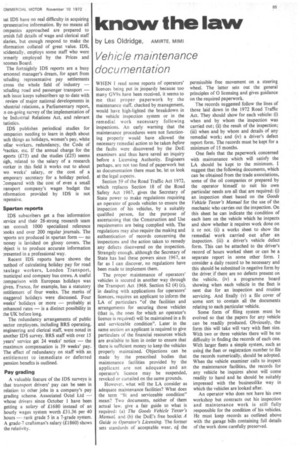know the law
Page 83

If you've noticed an error in this article please click here to report it so we can fix it.
by Les Oldridge, AMIRTE, MIMI
Vehicle maintenance documentation
WHEN I read some reports of operators' licences being put in jeopardy because too many GV9s have been received, it seems to me that proper paperwork by the maintenance staff, checked by management, would have high-lighted the breakdown in the vehicle inspection system or in the remedial work necessary following inspections. An early warning that the maintenance procedures were not functioning properly would have allowed the necessary remedial action to be taken before the faults were discovered by the DoE examiners and thus have saved an inquiry before a Licensing Authority. Engineers perhaps, are not too fond of paperwork but as documentation there must be, let us look at the legal aspects.
Section 59 of the Road Traffic Act 1972, which replaces Section 18 of the Road Safety Act 1967, gives the Secretary of State power to make regulations requiring an operator of goods vehicles to ensure the inspection of his vehicles, by a suitably qualified person, for the purpose of ascertaining that the Construction and Use requirements are being complied with. The regulations may also require the making and authentication of records concerning the inspections and the action taken to remedy any defects discovered on the inspection. Strangely enough, although the Secretary of State has had these powers since 1967, as far as I can discover, no regulations have been made to implement them.
The proper maintenance of operators' vehicles is secured in another way through the Transport Act 1968. Section 62 (4) (c), in dealing with applications for operators' licences, requires an applicant to inform the LA of particulars "of the facilities and arrangements for securing those vehicles (that is, the ones for which an operator's licence is required) will be maintained in a fit and serviceable condition". Later in the same section an applicant is required to give particulars of the financial resources which are available to him in order to ensure that there is sufficient money to keep the vehicles properly maintained. Objections can be made by the prescribed bodies that maintenance facilities provided by the applicant are not adequate and an operator's licence may be suspended, revoked or curtailed on the same grounds.
However, what will the LA consider as adequate maintenance facilities? What does the term "fit and serviceable condition" mean? Two documents, neither of them actual law. give a fair guide to what is required: (a) The Goods Vehicle Tester's Manual, and (b) the DoE's free booklet A Guide to Operator's Licensing. The former sets standards of acceptable wear, eg the
permissible free movement on a steering wheel. The latter sets out the general principles of 0 licensing and gives guidance on the required paperwork.
The records suggested follow the lines of those laid down in the 1972 Road Traffic Act. They should show for each vehicle: (i) when and by whom the inspection was carried out; (ii) the result of the inspection; (iii) when and by whom and details of any remedial work; and (iv) a driver's defect report form. The records must be kept for a minimum of 15 months.
One feels that the paperwork concerned with maintenance which will satisfy the LA should be kept to the minimum. I suggest that the following documents, which can be obtained from the trade associations, some of the oil companies or prepared by the operator himself to suit his own particular needs are all that are required: (i) an inspection sheet based on the Goods Vehicle Tester's Manual for the use of the mechanic who carries out the inspection. On this sheet he can indicate the condition of each item on the vehicle which he inspects and show whether it requires work done on it or not. (ii) a works sheet to show the remedial work carried out after an inspection. (iii) a driver's vehicle defect form. This can be attached to the driver's record of hours worked sheet or can be a separate report in some other form. I consider a daily record to be necessary and this should be submitted in negative form by the driver, if there are no defects present on the vehicle. (iv) a programme board showing when each vehicle in the fleet is next due for an inspection and routine servicing. And finally (v) a file cover of some sort to contain all the documents relating to each particular vehicle.
Some form of filing system must be evolved so that the papers for any vehicle can be readily produced. Obviously, the form this will take will vary with fleet size. With two or three vehicles there will be no difficulty in finding the records of each one. With larger fleets a simple system, such as using the fleet or registration number to file the records numerically, should be adopted. When the vehicle examiner calls to inspect the maintenance facilities, the records for any vehicle he inquires about will come readily to hand and he should be suitably impressed with the businesslike way in which the vehicles are looked after.
An operator who does not have his own workshop but contracts out his inspection and maintenance work is still fully responsible for the condition of his vehicles. He must keep records as outlined above with the garage bills containing full details of the work done carefully preserved.




































































































































